Lafayette
Associate Director, Indiana Business Research Center, Kelley School of Business, Indiana University, Indianapolis
The mantra of the Clinton campaign in the 1990s was “It’s the economy, stupid.” The new mantra for candidates in the upcoming national elections may well be “It’s jobs, stupid.” The economy is said to be going strong, with significant growth in Gross Domestic Product, rising wages, and increases in productivity. But job losses continue to plague much of our state and many other states in the Midwest and East. The Lafayette area has not been immune to the dichotomy of a strengthening economy that is losing jobs. The manufacturing sector in Lafayette continues to shrink in the number of jobs, even while it shows continued increases in earnings. The economy of Lafayette continues its structural shift to one heavily dominated by service-providing businesses and organizations, as measured by the federal government (see Figure 1).
Figure 1
Lafayette Metro Area Jobs
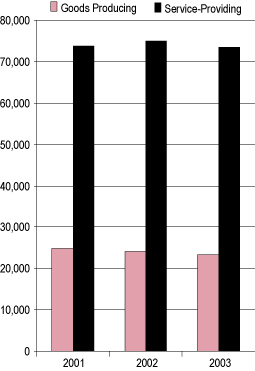
Lafayette lost 1,800 jobs between October 2001 and October 2003. Not surprisingly, the majority of those jobs were in the durable goods sector (-1,500). The loss of 2,400 jobs in the private sector was offset somewhat by job gains in education, government, and the leisure and hospitality industries (see Figure 2). During the past two years, the unemployment rate has also crept up, to 4 percent by September of 2003. And there has been a slight decline in the labor force of the area (-0.7 percent) between September 2002 to September 2003.
Figure 2
Changes in Jobs by Sector Within the Lafayette Metro,
October 2001 to October 2003
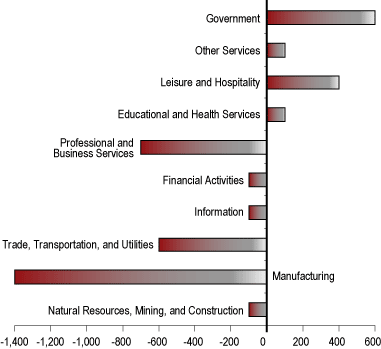
While new housing was a significant boon to many communities, including Lafayette, recent trends show the Lafayette metro area had 143 fewer building permits between 2002 and 2003 (based on September year-to-date figures for both of those years), or a decline of 12.4 percent. The decline occurred mainly with single family units, which was only slightly offset by the significant increase in the number of structures authorized with five or more units (see Figure 3).
Figure 3
Lafayette Metro Area Building Permits
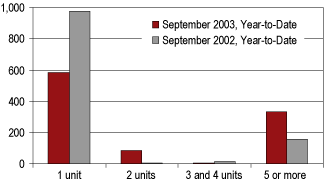
Since Census 2000, population growth has increased by 3,152, with continuing
increases projected over the next two decades.
So, what is the economic prognosis for Lafayette? It will remain a hub for
commuters from other counties (see Figure 4), as well as a
central focal point for manufacturing and education jobs.
Figure 4
Lafayette Commuting Patterns, 2002
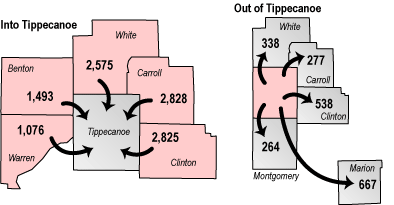
The loss of jobs in the professional and technical services sector is cause for concern, considering the focus of the state and central Indiana on the life sciences and information technology. The heating up of the economy in 2004 will be felt in Lafayette, but perhaps not fast enough to stem the tide of reduced jobs in manufacturing, which have historically kept the average wage per job relatively high (see Table 1).
Table 1
Lafayette’s Annual Covered Employment and Wages Over Time (NAICS)
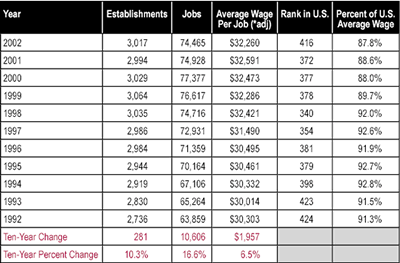
The strengths of having a major university will continue to provide a strong base for employment in the government and education sectors, while the initiatives of Purdue University in the life sciences and certified technology park may help the area maintain, or even significantly increase, its level of personal income. And of course, the area’s own economic development initiatives are geared to take advantage of the forecasted growth of the economy.
Also in this Issue…
- Outlook for 2004
- The U.S. Economy
- The International Economy
- Financial Forecast
- Corporate Governance and Reporting
- Housing
- Indiana
- Anderson
- Bloomington
- Columbus
- Evansville
- Fort Wayne
- Gary
- Indianapolis
- Kokomo
- Lafayette
- Muncie
- New Albany
- Richmond
- South Bend/Mishawaka and Elkhart/Goshen
- Terre Haute
- Outlook Summary for 2004



